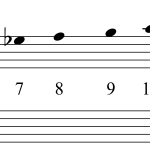VI. Jazz
Jazz Voicings
Megan Lavengood
Key Takeaways
- Space chords to mimic the spacing of the harmonic series: use large, wide intervals in lower registers, and smaller, closer intervals in upper registers.
- Extensions should be voiced in the higher voices.
- If you double a note, usually double either the bass or the root of the chord.
- Omitting the fifth of the chord is almost always perfectly acceptable.
- Use smooth or “lazy” voice leading: move each voice as little as possible between chords to achieve a smooth, easy-to-perform sound. A common smooth voice-leading schema in jazz is to lead from the third of one chord to the seventh of the next, while another line connects the ninth of the first chord to the thirteenth of the second chord.
- Guidelines can be ignored, but this should be a conscious and deliberate decision to achieve a desired effect.
So far in this unit, you have written chords in an unvoiced format. While unvoiced chords are useful for conceptualizing harmony, you would not want to perform these tall stacks of thirds. This chapter will discuss how to voice these harmonies in a manner that is idiomatic to jazz.
Spacing
The common spacing of chord members in musical textures has much to do with acoustics. We discuss pitches as specific frequencies—for example, A 440, the note to which most orchestras tune, refers to pitch A that has a frequency of 440 Hertz (Hz). But in fact, when an acoustic instrument plays A 440, 440 Hz is only one of the frequencies that is activated at that moment in time. The instrument will also activate the harmonics above that pitch, because the vibrating body causes other, shorter vibrations to occur simultaneously. These harmonics are part of what create an instrument’s unique timbre.
The harmonic series is approximated in Example 1. [1]

Note that the pitches are spaced widely apart in the lower harmonics, but become closer and closer together in the upper harmonics: the distance between partials 1 and 2 is an octave, but beginning at partial 13, the distance between subsequent partials is only a half step.
In general, spacing in music approximates the harmonic series: notes are further apart in lower registers, and closer together in higher registers. Putting notes close together in a low register tends to sound muddy and dissonant, even when the chords are consonant. When notes are spaced wide apart in the upper registers, the upper note will sound quite prominent and isolated in the texture (though this can sometimes be a good thing).
Remember that the bass line is probably played by the upright bass—and this instrument sounds an octave lower than written, so its lowest note is an E1, three Es below middle C. It’s normal for the bass to be in a register very much apart from the rest of the ensemble.
Chord extensions should be left in the upper registers of the texture. Recall that this is reflected in their names—a thirteenth is not the same as a sixth in jazz harmony. Voice the thirteenth somewhere above the seventh of the chord; otherwise, it will sound like the sixth.
Doubling
Most textures have more notes going at a time than the number of pitch classes in a given chord. This necessitates doubling some of the notes of the chord—putting the same note in more than one voice.
In general, a safe note to double is the bass note. Most often, the bass note is a relatively stable member of the chord. Because it’s the foundation of the texture, it sounds good to double the bass.
Another good option is to double the root of the chord, even if it is not in the bass. The root note, like the bass, is typically a stable tone, and will strengthen the chord when doubled.
Omitting Notes
Jazz harmonies often contain many notes, thanks to the common practice of extending the harmonies. It often wouldn’t be desirable for all these notes to be given equal weight in the voicing, so it’s common to omit some notes when voicing these extended harmonies.
The most common note to omit is the fifth of the chord. Because the fifth is an early pitch in the harmonic series (partial 3), it tends to strengthen the root of the chord without adding much character on its own. Listen and compare the various chords in Example 2, and notice that removing the fifth does very little to alter the overall sound of the chord, whereas omitting the seventh or root alters the sound substantially!
Example 2. Omitting the fifth is common, as it does not substantially alter the sound. The seventh and root are hardly ever omitted.
Omitting the root runs the risk of destabilizing the entire chord. However, if there is a bass player in the performing ensemble, you may deliberately omit the root in the other voices. The bassist will typically provide the root of the harmony and ensure that the chord sounds stable. The last chord in Example 2, then, would sound just fine if a bassist were playing a G below that voicing.
When dealing with extended chords, it becomes possible or desirable to omit other members of the chord besides the fifth, but it is difficult to generalize here. Usually, omitting tones is done to avoid excessive dissonance with other important chord members.
Smooth Voice Leading
We have been discussing harmonies as vertical entities so far: as a stack of notes that go bottom-to-top on the page. Vertical thinking is used a lot in music theory and by pianists and guitarists, but for almost everyone else, music is experienced horizontally: as a sequence of notes in time. It’s important for musicians to be able to think of music both vertically and horizontally through voice leading.
Voice leading in jazz and many other styles should generally be smooth—that is, voices should ideally move as little as possible when going to a new chord (except the bass, which often leaps). Smooth voice leading helps different chords sound more logically connected (Example 3). When writing your own chord progressions, it may be helpful to imagine your voices as lazy: they want to move as little as possible! The smallest possible move is the common tone: not moving at all, but instead remaining on a single tone that is common to both chords. The next most preferable movement is movement by whole or half step. Skips (movement by third) are also easy to perform and easy to sing, and there are many situations that will force you to skip when voice leading.
Leaps are primarily used to provide contrast and excitement in voice leading. They are to be used sparingly, and with good reason. Leaps sound most natural when they are within a single chord: because the chord underpinning the horizontal movement is staying the same, it’s easy for the voice to leap within that chord. When the chord is changing, though, adding leaps tends to make the chords sound disconnected and can make the piece difficult to perform. Leaping over a chord change is certainly possible, but it may take extra practice, and remember: your voices are lazy!
Example 3. Smooth voice leading helps chords sound connected to one another.
Typical Jazz Voicing
In jazz, a common voice-leading trick is to connect the thirds and sevenths of adjacent chords, as the saxophone and trumpet do in Example 3. The instrument that has the third of the chord in the first chord moves to the seventh in the second chord, and vice-versa (Example 4). This voice-leading pattern works with any two chords whose roots are related by fifth (G–C, A–E, etc.) This is a good foundation for all your voice leading. Build onto this foundation by playing with adding extensions and keeping the principle of smooth or lazy voice leading in mind. For example, adding an alternation between ninths and thirteenths to this voice-leading schema adds a third smooth line to this progression between fifth-related chords (Example 5). This yields a typical four-part jazz voicing that is easy to play.


Extensions can often be added to create additional smooth voice-leading lines, as shown in Example 5 above. But how do you know which extensions to use? There are no hard-and-fast rules about choosing extensions, and because extensions are typically improvised and not notated, it can be difficult for a beginner to know what’s common. Example 6, which you may also download as a handout, demonstrates the most common extensions for chords of certain qualities, organized from simple to complex. Experimenting with these extensions will help a beginner to develop a sense of what sounds most stylistic.
Example 6. Common extensions to add for each chord quality.
Guidelines versus Rules
Most of the above principles are not really rules that you must follow, but rather guidelines for writing stylistically. The guidelines here represent what is most common in jazz music.
Guidelines are not always followed, but knowing them empowers you to choose not to follow them with the full understanding of the resulting sound. In other words, feel free to break the rules, but make sure you know why you’re doing it!
- Coker, Jerry. 1984. Jazz Keyboard for Pianists and Non-Pianists: Class or Individual Study. Miami: Alfred Music.
- Common chord symbols with extensions handout, by Brendan Schnabel.
- Voicing worksheet (.pdf, .mscz). Asks students to identify common voice leading patterns in a voiced jazz texture and to write voiced chord progressions with good voice leading.
Media Attributions
- Harmonic series
- Third-seventh voice leading
- third-seventh-ninth
- The notes of the harmonic series do not conform to twelve-tone equal temperament, but they have been notated at the nearest pitch for the sake of convenience. ↵
A series of notes whose frequencies are multiples of the first frequency: 1:1, 1:2, 1:3, 1:4, 1:5, etc. Starting with the pitch C₂, this would result in the series of pitches C₂, C₃, G₃, C₄, E₄, G₄, B♭₄, C₅, etc.
Distribution of notes in a chord into idiomatic registers for performance.
The lowest part (or "voice") of a composition.
The lowest note of a triad or seventh chord when the chord is stacked in thirds.
Spelling chords stacked in thirds or in closed position, within a single staff, usually for abstract or theoretical purposes, rather than for performance.
The physical science of sound.
A unit of measurement for the frequency of a sound, equivalent to one cycle per second.
An overtone of a complex sound that occurs at a whole-number ratio to the fundamental.
A component frequency within a complex tone's set of overtones.
A group of pitches that are octave equivalent and enharmonically equivalent.
Duplicating some notes of a chord in multiple parts.
The way a specific voice within a larger texture moves when the harmonies change. For example, in a choir with four parts, soprano/alto/tenor/bass, one might discuss the voice leading in the tenor part as the entire choir moves from I to V.
A tone that is present in more than one chord.
Melodic movement by third.
